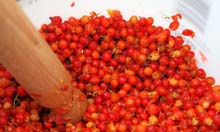 |
| MOUNTAIN ASH PLANTED IN SPRING OF 2016.... |
 |
| ...LADEN WITH BEAUTIFUL FRUIT |
Another sign that fall is here is the ripening of mountain ash berries. Mountain ash, small trees in the genus Sorbus in the Rose Family, and closely related to apples and pears, are of course not an ash species at all, as ash are in the genus Fraxinus which
is in the Olive Family. The common name Mountain ash relates to its
feather compound leaves, which are ash-like in appearance. The two tree
genera bear no other similarity, and scientific nomenclature of plants
is based upon flower structure and its evolution.
The mountain ash species most likely to be encountered are very
similar in appearance and use, the most popular being the European
mountain ash, Sorbus aucuparia, and the American mountain ash, Sorbus americana. I find them very difficult to tell apart (although the winter buds of americana tend
to be sticky), and the European species is very much naturalized and
commonly found growing as a volunteer in the wild around human
habitation. For landscape purposes, the two species are very comparable,
even the orange, edible (not very good tasting) berries being very similar. In recent years the
most popular mountain ash sold by nurseries is the also-native showy
mountain ash, Sorbus decora, which has berries that are red
rather than orange. The Korean mountain ash is sometimes available in
nurseries, and is also a very handsome tree. The European mountain ash
has long been called the rowan tree in England.Mountain ash trees have great landscape value, as they are beautiful in flower and in fruit, and provide great wildlife food. They are a fine small landscape or street tree. Many individual mountain ash also have good fall leaf color, and in some countries wine is made from the berries, or the berries are used to flavor a seasonal beer. Horticultural varieties of mountain ash with truly edible berries have been developed in Germany and Russia, and although I am not personally familiar with them they sound like a good idea.
Mountain ash are all small trees or multi-stemmed large shrubs of the far north, the North American species being trees of the Boreal Forest biome; they are semi-shade tolerant and not particular as to soil conditions.
Sorbus species do have some problems, one being fire blight, which is also a very common disease of apples, crab apples, pears and quince. Sap suckers, which are small woodpeckers, can be very destructive, drilling holes in the soft bark in order to drink the flowing sap in the spring. They can girdle and kill trees they take a liking to.
Knowing the difference between mountain ash (Sorbus) and true ash trees (Fraxinus) is very important when dealing with Emerald Ash Borer, as that pest only attacks Fraxinus species.
HOW TO MAKE ROWANBERRY WINE (from the English newspaper the Manchester Guardian)
2kg rowanberries, snipped off with scissors, picked over and washed
1.2kg sugar
500ml white grape juice concentrate
Juice of 2 lemons
1 tsp of wine tannin
1 tsp pectolase
1 tsp yeast nutrient
Sachet of white wine yeast
About 4 litres of boiling water
1.2kg sugar
500ml white grape juice concentrate
Juice of 2 lemons
1 tsp of wine tannin
1 tsp pectolase
1 tsp yeast nutrient
Sachet of white wine yeast
About 4 litres of boiling water
Put the berries in a food grade plastic bucket and mash them coarsely with the end of a rolling pin. Boil the water then stir in the sugar until dissolved, bring to the boil again and immediately pour over the berries. Cover and allow to cool. Add the grape concentrate, pectolase, lemon juice and tannin. Cover and leave for 24 hours then stir in the yeast nutrient and yeast (activated if necessary).
Cover and leave for a week, stirring every day for the first five days. If your brew has separated nicely into three layers – sludge / liquid / sludge – carefully place the end of a siphon at a strategic height and siphon off the liquid into a clean demi-john – though a bit of sludge won't hurt. Otherwise strain through clean muslin using a funnel. Top up to the bottom of the neck with boiled and cooled water if necessary. Fit your bung and fermentation lock and leave to ferment for a couple of months.
Rack off into a fresh demi-john and leave until all fermentation has stopped for a week, then bottle. Rowanberry wine benefits from a long maturation period in the bottle – at least a year.












No comments:
Post a Comment